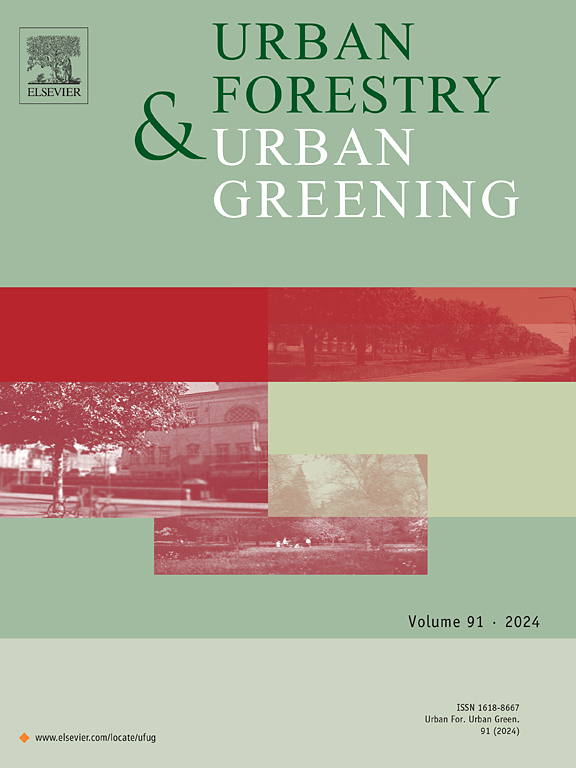灌木能储存多少碳?芬兰的测量和分析
IF 6.7
2区 环境科学与生态学
Q1 ENVIRONMENTAL STUDIES
引用次数: 0
摘要
从大气中有效固碳对于应对气候变化至关重要。许多城市都制定了雄心勃勃的碳中和目标,这凸显了城市植被作为碳汇的重要意义。将城市植被融入城市形态涉及一个多阶段的决策过程,规划和设计在决定空间分配和植物物种选择方面发挥着关键作用。碳智能设计决策通常以排放数据库和环境产品声明(EPD)为基础,而城市植被的综合数据却十分缺乏。本研究旨在利用干重测量法评估芬兰城市灌木的碳储量。测量方法包括分离灌木的地上部分和地下部分并评估大小指数(SIs)。结果表明,不同物种的根系质量占总生物量的比例存在差异。此外,通过吸吮根茎网络传播的植物的地下生物量无法通过大小指数来预测。虽然尺寸指数不能直接描述地下生物量,但可以预测总干重。将数据归纳为灌木的大小类别可以了解碳储量,但进一步的研究至关重要,尤其是在城市环境中实施植被的过程中。本文章由计算机程序翻译,如有差异,请以英文原文为准。
How much carbon can shrubs store? Measurements and analyses from Finland
Effective sequestration of carbon from the atmosphere is essential to combating climate change. Many cities have set ambitious carbon neutrality goals, highlighting the significance of urban vegetation as a carbon sink. Integrating urban vegetation into the urban form involves a multi-stage decision-making process, with planning and design playing a key role in the determination of space allocation and plant species selection. While carbon-smart design decisions are often based on emission databases and environmental product declarations (EPD), comprehensive data for urban vegetation is lacking. This study aims to assess carbon stocks in urban shrubs of Finland using dry-weight measurements. The measurements involve separating above- and below-ground parts of shrubs and assessing size indices (SIs). The results indicate species-specific differences in the proportion of root mass to total biomass. Furthermore, the below-ground biomass of plants spreading through sucking rhizome networks cannot be predicted by the size index. Although SIs do not directly describe below-ground biomass, they can predict the total dry weight. Generalising the data to shrub size categories provides an understanding of carbon stocks, but further research is essential, particularly for the process of implementing vegetation in urban settings.
求助全文
通过发布文献求助,成功后即可免费获取论文全文。
去求助
来源期刊

Urban Forestry & Urban Greening
FORESTRY-
CiteScore
11.70
自引率
12.50%
发文量
289
审稿时长
70 days
期刊介绍:
Urban Forestry and Urban Greening is a refereed, international journal aimed at presenting high-quality research with urban and peri-urban woody and non-woody vegetation and its use, planning, design, establishment and management as its main topics. Urban Forestry and Urban Greening concentrates on all tree-dominated (as joint together in the urban forest) as well as other green resources in and around urban areas, such as woodlands, public and private urban parks and gardens, urban nature areas, street tree and square plantations, botanical gardens and cemeteries.
The journal welcomes basic and applied research papers, as well as review papers and short communications. Contributions should focus on one or more of the following aspects:
-Form and functions of urban forests and other vegetation, including aspects of urban ecology.
-Policy-making, planning and design related to urban forests and other vegetation.
-Selection and establishment of tree resources and other vegetation for urban environments.
-Management of urban forests and other vegetation.
Original contributions of a high academic standard are invited from a wide range of disciplines and fields, including forestry, biology, horticulture, arboriculture, landscape ecology, pathology, soil science, hydrology, landscape architecture, landscape planning, urban planning and design, economics, sociology, environmental psychology, public health, and education.
 求助内容:
求助内容: 应助结果提醒方式:
应助结果提醒方式:


